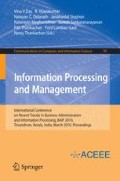Abstract
Intrusion Detection System (IDS) is the science of detection of malicious activity on a computer network. Due to the enormous volume existing and newly appearing network data, Data Mining classification methods are used for Intrusion Detection System. In this paper the classifying methods used are ID3, J48, Naive Bayes and OneR. The data set used for this experiment is kddcup1999. The dimensionality reduction is being performed from 41 attributes to 7 and 14 attributes based on Best First Search method and the 4 classifying methods are being applied. The result shows that ID3 and J48 method carry the highest accuracy and sensitivity with 7 and 14 attributes. Naive Bayes holds the highest degree of specification for all three dimensionalities. OneR has the worst Sensitivity with 7 and 14 attributes but the time taken by OneR for classification is very less. It is found that the optimal algorithm may vary based on the dimensionality.
Access this chapter
Tax calculation will be finalised at checkout
Purchases are for personal use only
Preview
Unable to display preview. Download preview PDF.
References
KDDCup99datasets, The UCI KDD Archive, http://kdd.ics.ucs.edu/databases/kddcup99/kddcup99.html
Peng, T., Zuo, W.: Data Mining for Network Intrusion Detection System in Real Time. Journal of Computer Science and Network Security 6(2), 173–177
Hybrid Model. International Journal of Computer Science and Network Security 9(10), 23–33 (October 2009)
Prasad, G.V.S.N.R.V., Dhanalakshmi, Y., Vijaya Kumar, V., Ramesh Babu, I.: Modeling. Modeling An Intrusion Detection System Using Data Mining and Genetic Algorithms Based on Fuzzy Logic 8(7), 319–325 (2008)
Panda, M., Patra, M.R.: A Comparative Study of Clustering Algorithms for Building a Network Intrusion Detection Model. Journal of Computer Science
MIT Lincoln Lab., Information Systems Technology Group, The 1998 Intrusion detection off-line evaluation plan (March 25, 1998 )
WEKA: Data Mining Software in Java (2008), http://www.cs.waikata.ac.nz/ml/weka
J48 classifier, http://www.d.umn.edu/~padhy005/Chapter5.html
Zhang, H.: The Optimality of Naive Bayes. In: FLAIRS 2004 conference (2004), http://www.resample.com/xlminer/help/NaiveBC/classiNB_intro.htm
Ross, P.: OneR: the simplest method
ROC Signal detection theory and ROC analysis in psychology and diagnostics : collected papers; Swets (1996)
Author information
Authors and Affiliations
Editor information
Editors and Affiliations
Rights and permissions
Copyright information
© 2010 Springer-Verlag Berlin Heidelberg
About this paper
Cite this paper
Kavitha, B., Karthikeyan, S., Chitra, B. (2010). Efficient Intrusion Detection with Reduced Dimension Using Data Mining Classification Methods and Their Performance Comparison. In: Das, V.V., et al. Information Processing and Management. BAIP 2010. Communications in Computer and Information Science, vol 70. Springer, Berlin, Heidelberg. https://doi.org/10.1007/978-3-642-12214-9_17
Download citation
DOI: https://doi.org/10.1007/978-3-642-12214-9_17
Publisher Name: Springer, Berlin, Heidelberg
Print ISBN: 978-3-642-12213-2
Online ISBN: 978-3-642-12214-9
eBook Packages: Computer ScienceComputer Science (R0)

